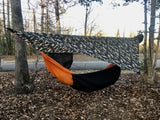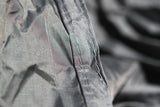The Streamliner is a different style of hammock for the adventurous hanger. For years, catenary curves have been applied to tarps and tents, but not very often has the principle been applied to a hammock.
I took the Tree Runner Hammock and applied a catenary curve to the ends and sides.
The ends have a 3" deflection, while the sides have a 5" on each side.
The benefits of this are two fold. The curves at the ends help to lessen calf ridge. At the same time, the curves on the sides minimize the walled in effect from the side material. The width of the hammock is 10 inches narrower in the center, than the width of the fabric.
To be up front, the Streamliner is not for everyone. Due to the nature of the Cat Curves, the edges of the hammock do become more taut under load than a regular hammock. So, when using it as a chair for lounging, the edges can dig into the back of the legs.
Video Review 1 | Video Review 2
Features:
- Sewn channels at each end
- Standard Curve Depth: Ends - 3"; Sides - 5"
- Many options are available, so if you have a specific question on any of them, please contact me
- Optional Zippered Shoulder Pouch (12"x8")allows you to keep essentials close by and is sewn onto the hem on either left or right shoulder positions
- Optional Under Quilt Hooks (i.e. pack hooks) are spaced approximately 20" from the ends of the hammock unless you specify otherwise
- Please note: In order to hang your hammock, it is recommended to add a suspension set to your cart unless you already have one.
- The length of the Streamliner is measured along the center of the hammock and not the edges
- Note: Unless you have used a Streamliner before and know your specific ridgeline length that works best for you, it is advisable to start with an adjustable ridgeline
Comes with:
- Streamliner Hammock
- 2-Ended Stuff Sack size slightly large to accommodate suspension
Dimensions & Average Weights*:
With so many different Fabric choices, varying widths and add ons, weights will vary.
Which Hammock is Right for Me?
There are many different factors involved in this decision and what is right for one person may not be right for another. Here are a few guidelines:
Single Layer or Double - This will be affected by the weight of the user and your desired pack weight vs. comfort level. A double layer hammock weighs slightly more, but gives more support, allows for placement of a pad (or other insulation) between the layers, holds more weight and helps block wind and mosquitos.Fabric - There are also choices in the type and weight of fabrics used. I currently stock and mostly use the Hexon 1.6 line, but also have a variety of ripstops in the 1.1 oz - 1.9 oz range. And of course can order custom fabrics as needed.
The below weight guidelines are just estimates and generally focus on the limits of comfort in the hammock, as the closer you get to the limits of a material, the comfort tends to decrease more quickly. And these guidelines apply mostly to standard Nylon Ripstops. Some of the newer fabrics being developed and carried by some of the material vendors (such as Dutchware or Ripstopbytheroll), may have different weight guidelines that apply due to types of material and construction methods.
With a single layer hammock of 1.1 oz ripstop, it is generally recommended for use under 175 lbs. Going over 150, you will notice a slight loss in performance in lay. If you choose to go with the double layer 1.1, then the weight range increases to under 250 lbs.
1.6 oz ripstop fills in the gap between 1.1 & 1.9. It is recommended for weights under 200 lbs so as not to affect performance. A double layer 1.6 would increase that to around 350 lbs.
A hammock of 1.9 oz ripstop is recommended for under 225 lbs, while a double layer of 1.9 oz ripstop is good for up to 400 lbs.
*All weights are an average weight based on current materials. At times, due to different manufacturing processes from the material suppliers, these weights may change slightly. So, any advertised or quoted weight, is just an estimate.

























































